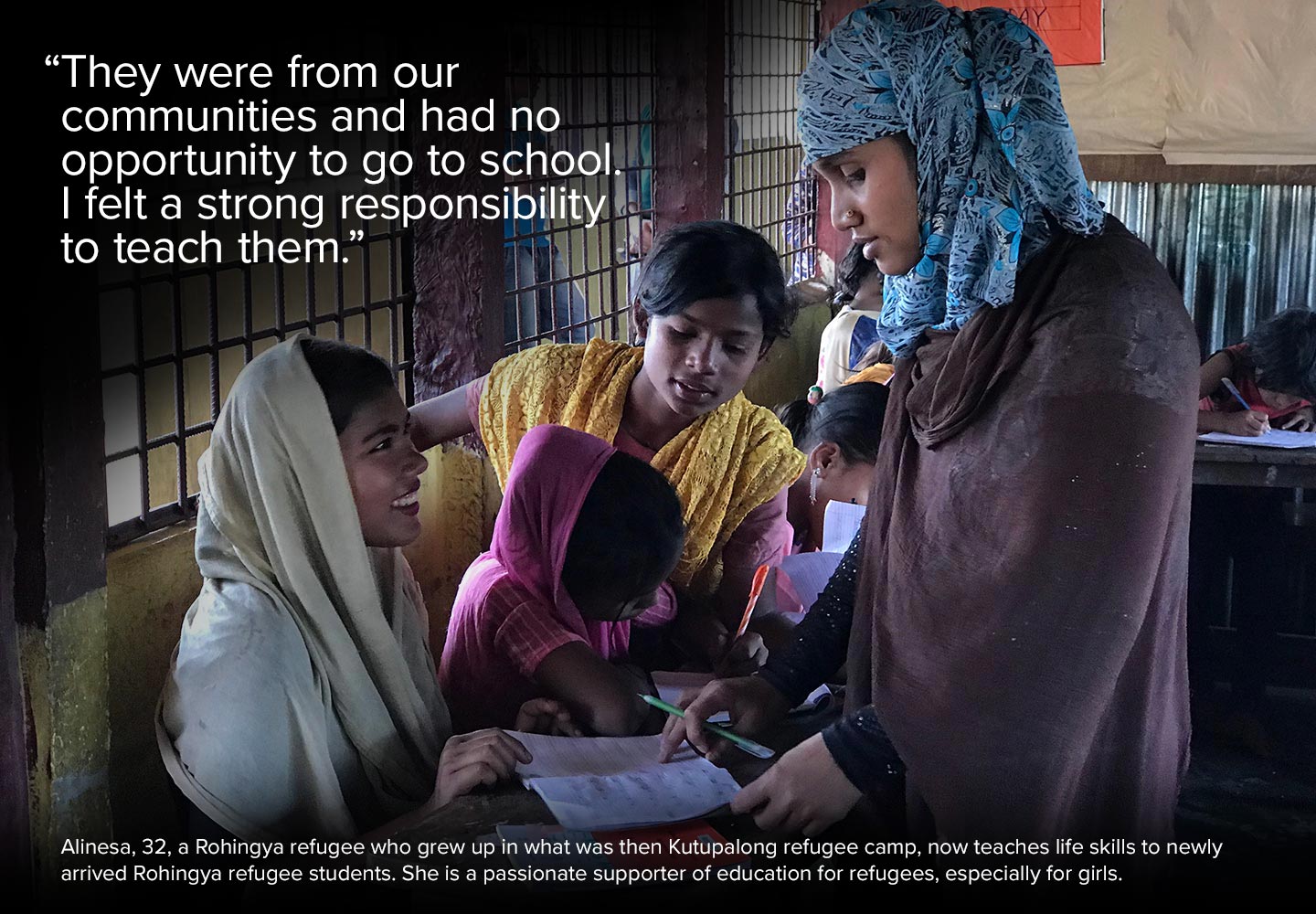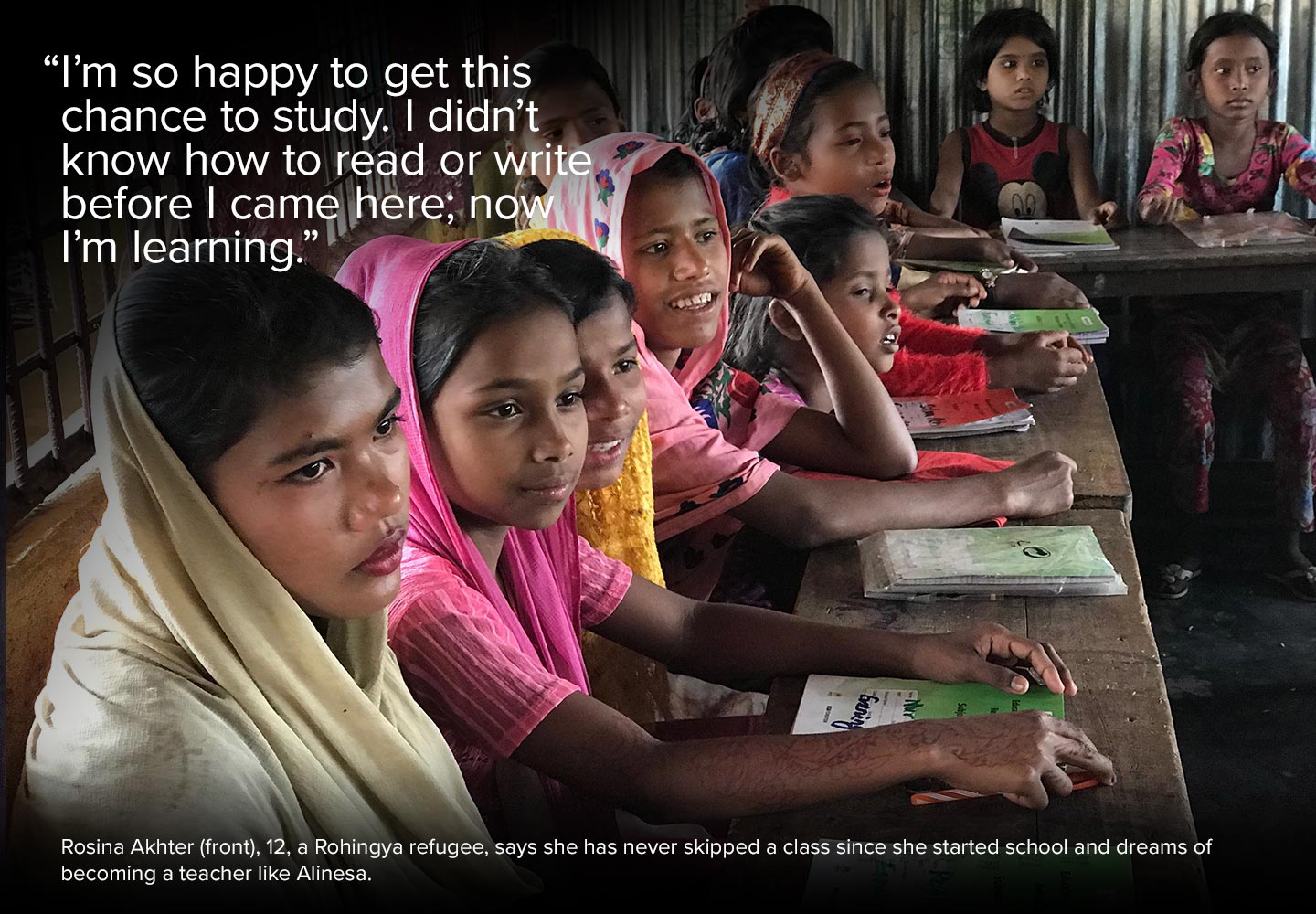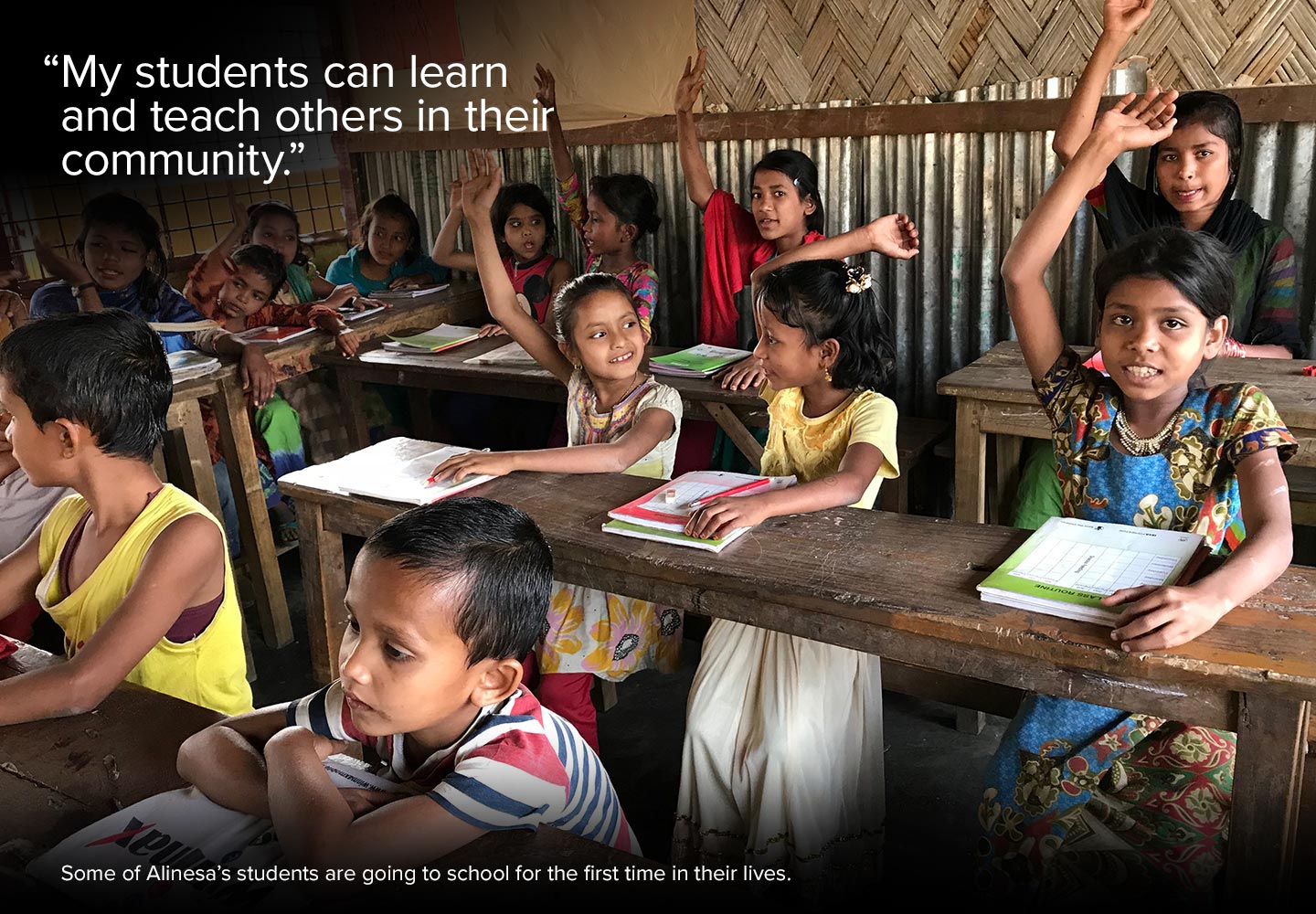Nur Kalima, 11, Rohingya refugee studying at a UNHCR-funded school in Kutupalong refugee settlement, Bangladesh. It is challenging for Rohingya girls to complete their education because of social pressures, early marriage and a lack of access to higher education. © UNHCR/Roger Arnold
Introduction
By Filippo Grandi, UN High Commissioner for Refugees
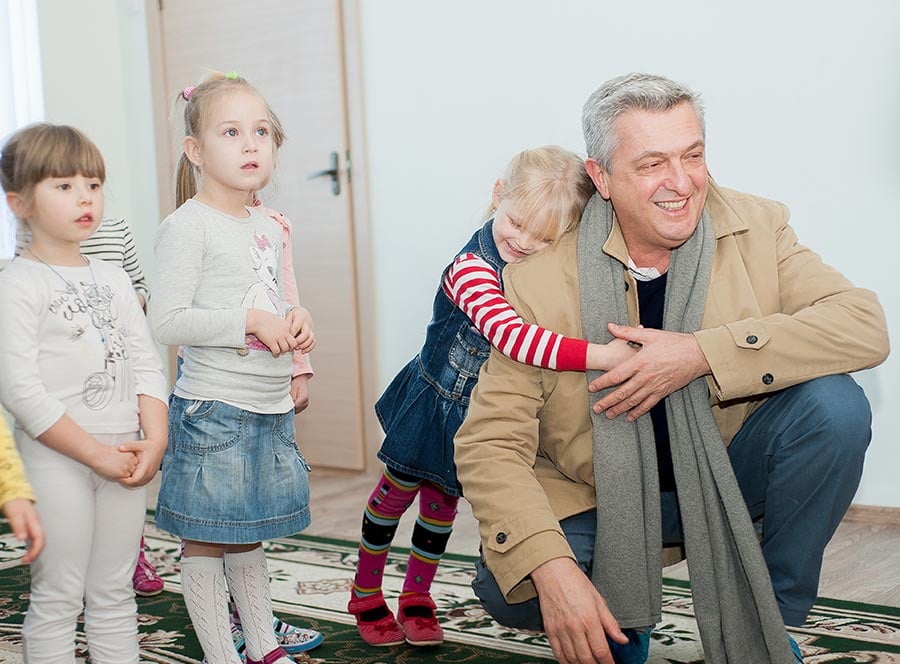
UN High Commissioner for Refugees, Filippo Grandi, visiting a repaired kindergarten in Luhansk, Ukraine. © UNHCR/Alina Cherkashina
Access to education is a fundamental human right. It is essential to the acquisition of knowledge and to “the full development of the human personality”, as the Universal Declaration of Human Rights states. More than that, education makes us more resilient and independent individuals. Yet for millions of women and girls among the world’s ever-growing refugee population, education remains an aspiration, not a reality.
Limited access to schooling perpetuates and magnifies the challenges of life in exile – finding work, staying healthy, holding on to dignity and hope. It also limits the potential of refugee women and girls to rebuild their lives, protect themselves against abuse and take a lead in shaping the lives of their communities.
Without an education, refugee women and girls are denied the confidence to speak out – to contribute to the strengthening of respect for human rights and fundamental freedoms around the world. Today’s students are tomorrow’s leaders. They are the ones who will help to foster peace and stability. They are the ones who will blaze trails for others to follow and set examples that future generations will seek to emulate. For the future security of their home countries, it is vital that refugee women and girls are given the keys of education to unlock their potential as leaders of peace.

Asma’a Adnan Saied, 23, Syrian refugee in Zaatari refugee camp, Jordan, studying English Literature at a university thanks to a DAFI scholarship (Albert Einstein German Academic Refugee Initiative).
© UNHCR/Antoine Tardy
“I’ll have a brighter future. For me and my family. And for the next generation of Syrians.”
Enabling refugee girls to get access to quality education requires action right across the board – from national education ministries and teacher training institutions, to communities and classrooms. This will not be easy: forced displacement has accelerated in recent years, straining facilities and infrastructure in countries that host refugees, many of which were already battling to provide adequate services to their own people. That’s why we at UNHCR are calling for an international effort to turn the tide.
Refugee girls often have fewer opportunities than boys, but UNHCR and its partners have identified ways in which we can widen their access to education. We now need support to implement these strategies globally and redress the imbalance.
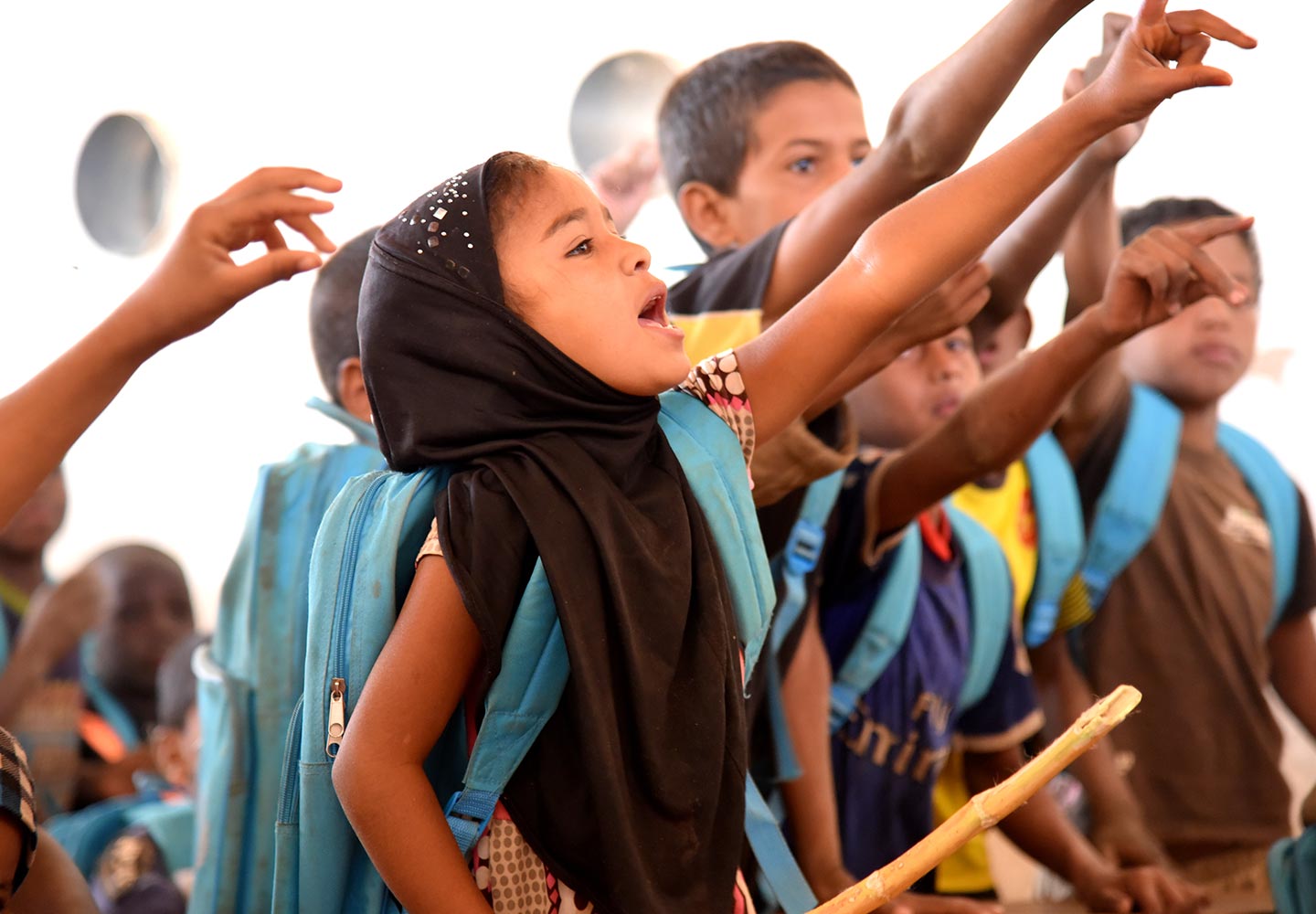
Refugee children from Mali compete to catch their teacher’s attention in one of the six primary schools in Mbera refugee camp, Mauritania. © UNHCR/Helena Pes
Good examples abound, and many countries are making changes to help more girls from both refugee and local communities attend school. Our task is to make sure this happens everywhere, and to help create stronger communities that unite to find solutions to shared challenges. We have found time and time again that measures to support refugee women and girls also have long-term benefits for the communities hosting refugees.
It is time for the international community to recognize the injustice of denying refugee girls and women an education. Please join us in demanding: “It’s her turn”. It’s her turn to be equipped with the confidence of education. If you give her this chance, there is no limit to her potential.
Rwanda: Best friends prove education is key for girls (William Davies, producer-videographer)
Why educate refugee girls?
A young girl at school in Kot Chandna, a remote village in Pakistan hosting Afghan refugees. © UNHCR/Sara Farid
Ensuring that refugee girls gain access to education is crucial to their empowerment and to the future prosperity of their families and communities. If all refugee girls can get an education, their families and communities are more likely to improve their social and economic position. The higher the level of education they manage to attain, the greater these benefits could be.[1]
School means routine, normality, purpose, and time away from the pressures and burdens of refugee life – important for all girls and boys but in some cases especially so for girls, who are vulnerable to exploitation and to sexual and gender-based violence. By learning about their rights and how to claim them, refugees are empowered. Education strengthens their resilience in the face of the huge challenges that confront people who have been forced from their homes.
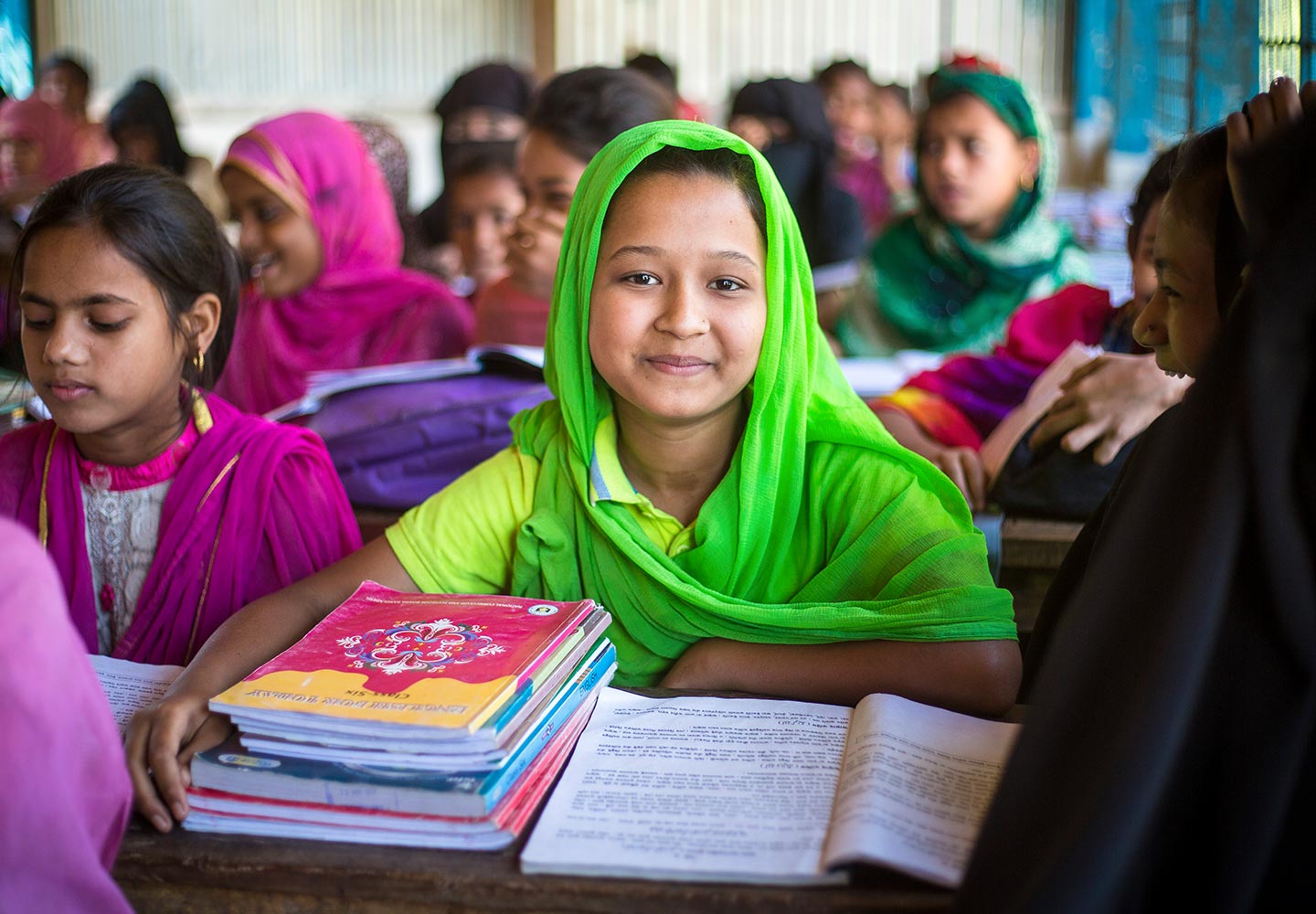
Sumaiya Akter, 12, Rohingya refugee in Kutupalong refugee settlement, Bangladesh. © UNHCR/Roger Arnold
“I come to school so that I can get a job and help educate orphan girls.”
Education is also protective. It reduces girls’ vulnerability to exploitation, sexual and gender-based violence, teenage pregnancy and child marriage. According to UNESCO, if all girls completed primary school, child marriage would fall by 14 per cent. If they all finished secondary school, it would plummet by 64 per cent.[2] For refugee girls and women facing the increased risks that come with forced displacement, education is particularly important.
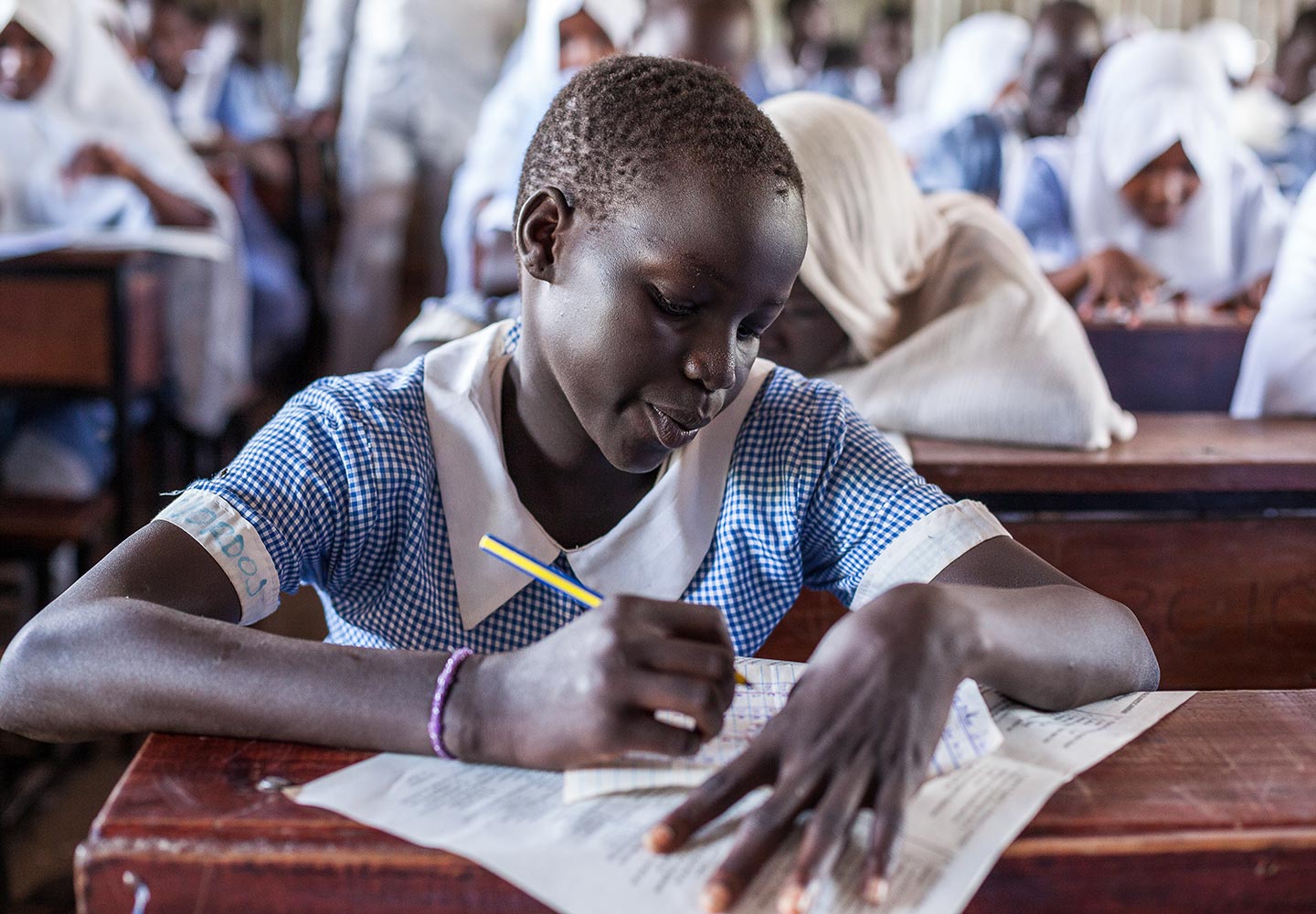
A young refugee girl taking her end of term exams at a school in Kakuma refugee camp, Kenya. © UNHCR/Samuel Otieno
UNESCO research shows that educated mothers are more likely to send their children to school, especially their daughters, and are more likely to support them in attaining a secondary and tertiary-level education. The further girls progress with their schooling, the more they develop leadership skills, entrepreneurship and self-reliance – personal qualities that will help their communities to flourish as they strive to adapt to their host countries or as they rebuild their own homes.[3]
Furthermore, UNESCO research shows that one additional year of school can increase a woman’s earnings by up to a fifth.[4] Such benefits are felt by everyone; in countries where education is equal for both sexes, per capita income is boosted by 23 per cent. A refugee girl’s time in exile should be considered an opportunity to develop and train her.
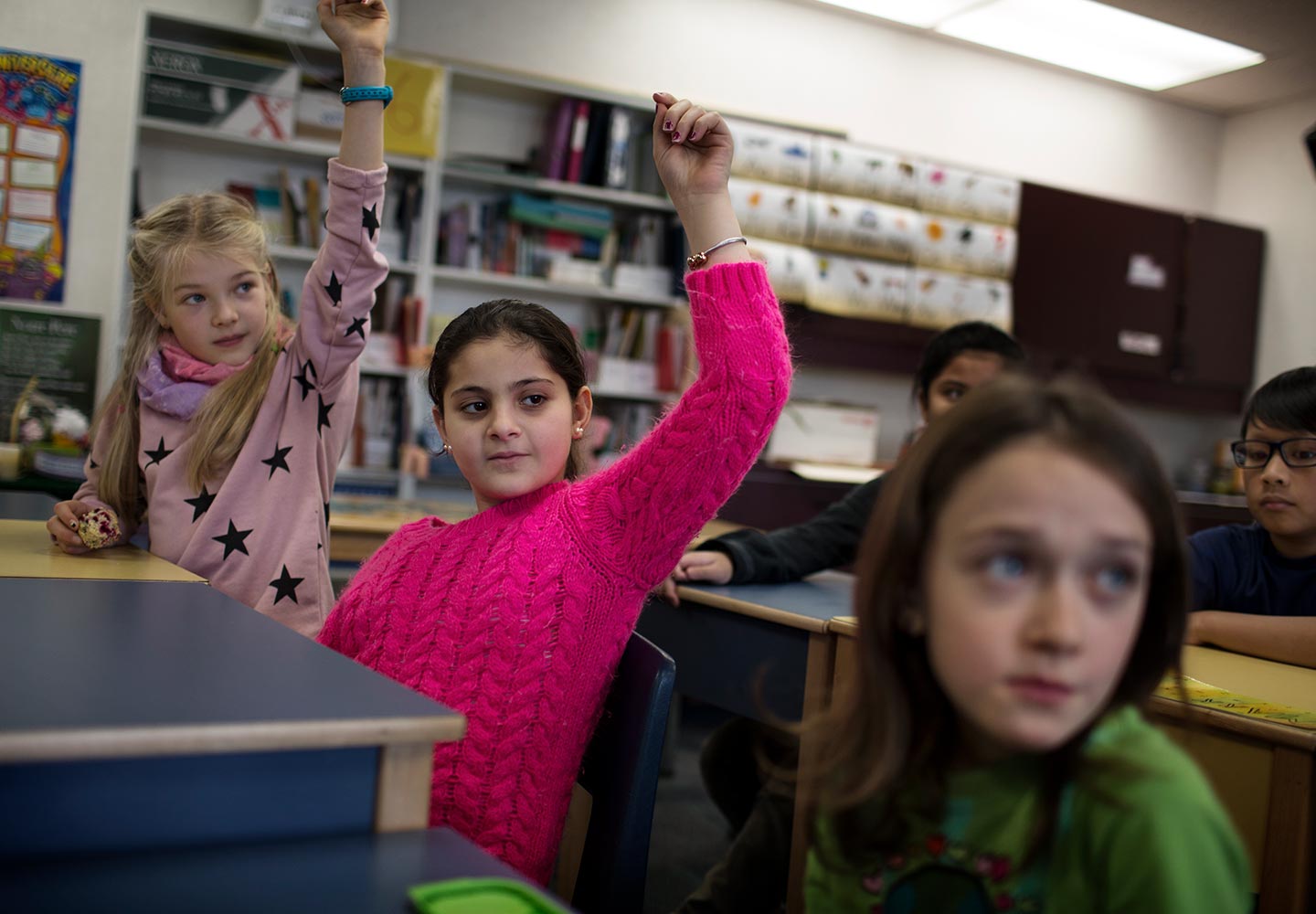
Reem Arafat (middle), a Syrian refugee girl at school in Whitehorse, Canada. © UNHCR/Annie Sakkab
If all women received a primary level education, child deaths from diarrhoea, malaria and pneumonia would fall, as innumerable studies show.[5] Deaths from diarrhoea, for example, the third-most frequent cause of child mortality, would be reduced by eight per cent if all mothers completed primary education, or by 30 per cent if they had secondary education, according to UNESCO.[6] These threats are especially acute in displacement situations. Educated women are more likely to be aware of where to find professional help – some of it life-saving – when pregnant or as new mothers, while the further they progress with their schooling the more aware they are of the benefits of nutrition and sanitation.
If we continue to neglect refugee girls’ education, the consequences will be felt for generations. It is time to make it a priority.
What is the scale of the challenge?
Natalia Rami Haddad, 14, a Syrian refugee with her Czech friend, Natálie Sembdnerová, 12, at high school in Hradec Králové, Czech Republic. In 2017, Natalia received an award from the Czech Ministry of Education for her efforts as a language student. © UNHCR/Michal Novotný
Ensuring that refugee girls are given access to education is crucial for their empowerment and the prosperity and increased resilience of their families and communities. But there are formidable barriers in their path. For refugee children around the world, both boys and girls, the school gates are a great deal harder to prise open than they are for their non-refugee peers.
As highlighted in UNHCR’s latest report on refugee education, only 61 per cent of refugee children have access to primary education, compared to an international average of 91 per cent. At secondary level, 23 per cent of refugee adolescents go to school, compared to 84 per cent globally. At tertiary level, while 34 per cent of university-age youth are in education, the figure for refugees is 1 per cent.
All refugees face significant barriers to education, but for the 84 per cent of refugees who are hosted in developing regions, the situation is particularly acute, with resources stretched and a chronic shortage of schools and teachers.[7]
Teacher works overtime to give Rohingya girls a chance to learn © UNHCR/Caroline Gluck
For refugee girls in these regions, it is even tougher. And as they get older, the gender gap keeps growing, as UNHCR statistics show. Data from the top three sub Saharan countries hosting refugees, Uganda, Ethiopia and Kenya, show that there is a greater proportion of refugee boys than refugee girls in school:
Primary education
- In Uganda, progress has resulted in nine refugee girls for every ten refugee boys enrolled in primary education.
- In Kenya and Ethiopia, there are only seven refugee girls for every ten refugee boys enrolled in primary education.
- According to UNESCO amongst local children in these countries there are equal numbers of boys and girls enrolled in primary education.
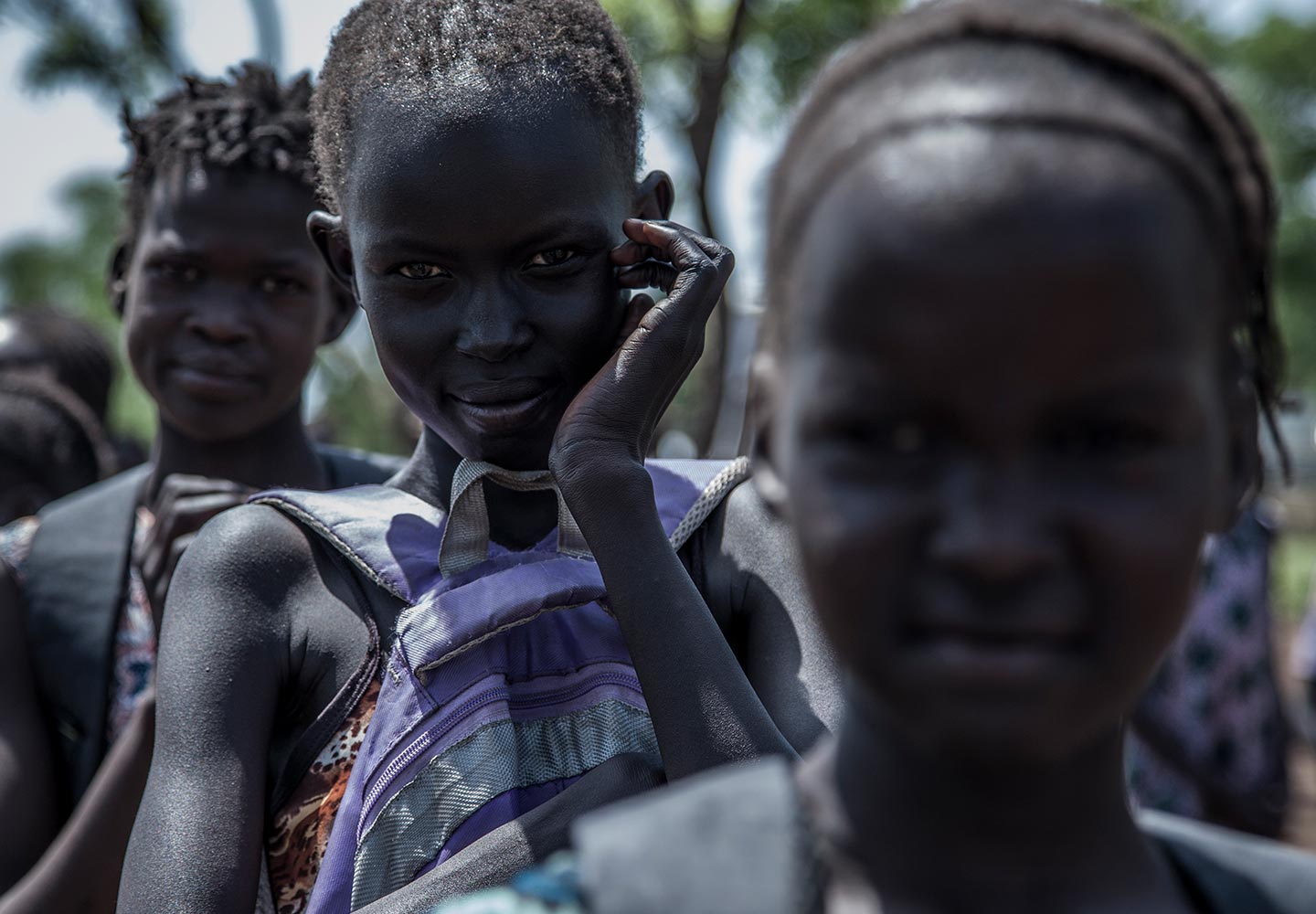
South Sudanese refugees at school in Nguenyyiel refugee camp, Ethiopia. Due to funding constraints, the school only goes up to fourth grade. : © UNHCR/Diana Diaz
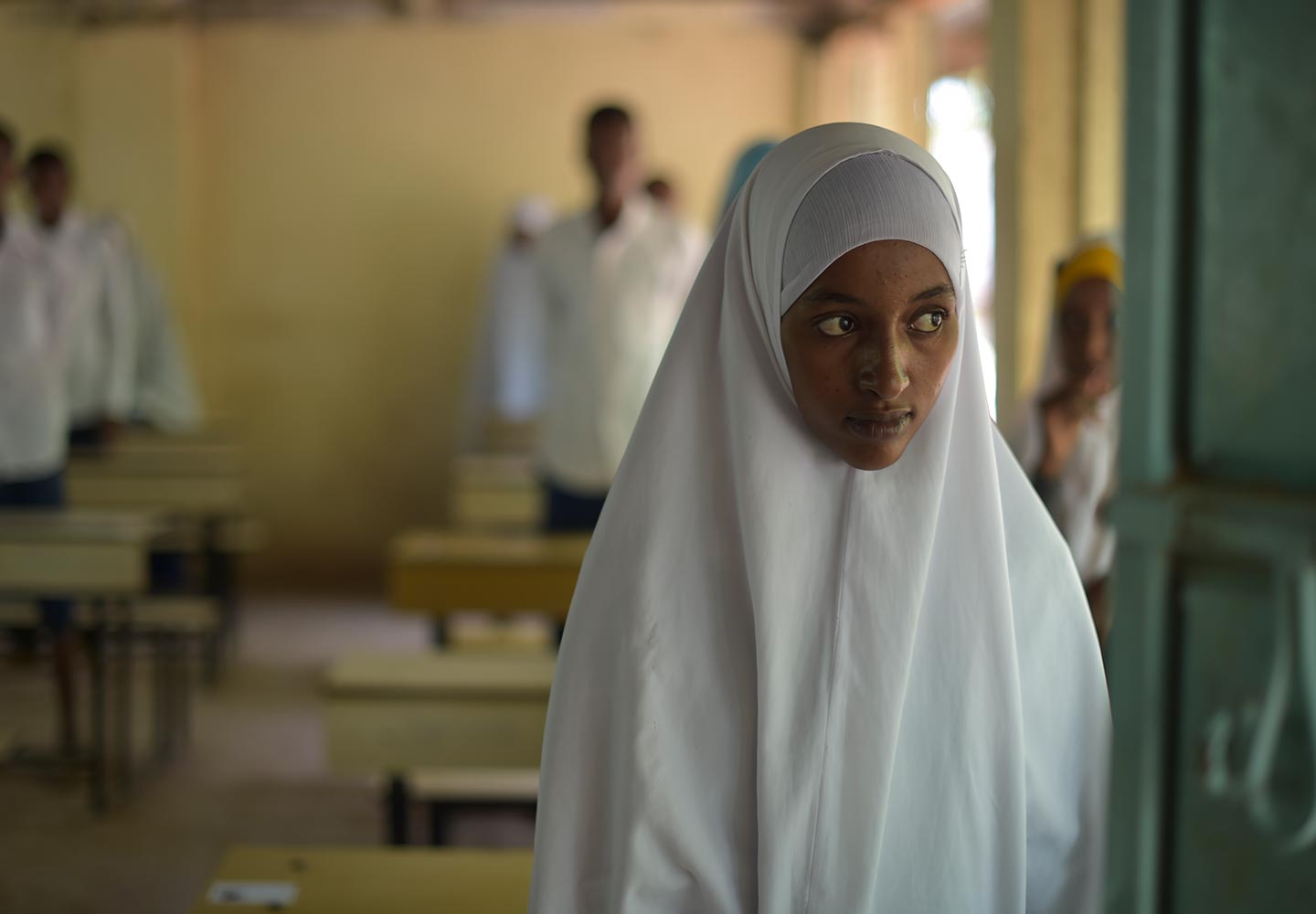
A Somali refugee girl after taking her secondary school exam in Dadaab refugee camp, Kenya. © UNHCR/Tobin Jones
Secondary education
- Refugee girls at secondary level are only half as likely to enrol as their male peers.
- In Uganda, there are five girls for every ten boys enrolled in secondary education.
- In Kenya and Ethiopia, there are four girls for every ten boys enrolled in secondary education.
- According to UNESCO, nine girls for every ten boys are enrolled in secondary school amongst the local population.
These disparities emerge even though girls make up half of the school-age refugee population.[8]
What are the barriers?
Refugee children from Burundi in Mahama refugee camp, Rwanda. Burundian refugee children attend Paysannat L School alongside children from the host community. © UNHCR/Georgina Goodwin
A major obstacle to both refugee boys and girls attending school is cost. According to UNHCR field staff, school fees, the price of uniforms, books and other learning materials and transportation are barriers to education for boys and girls alike. Even small costs can seem problematic for people who have suddenly had to abandon their livelihoods and are often denied the right to work.
But refugee girls are often at an even greater disadvantage in terms of “opportunity costs” – losses in terms of income and of domestic duties.[9] Collecting water or fuel, taking care of younger siblings or older relatives, household chores – these are all tasks that fall heavily on girls, while marrying daughters off removes them as a family “expense”.
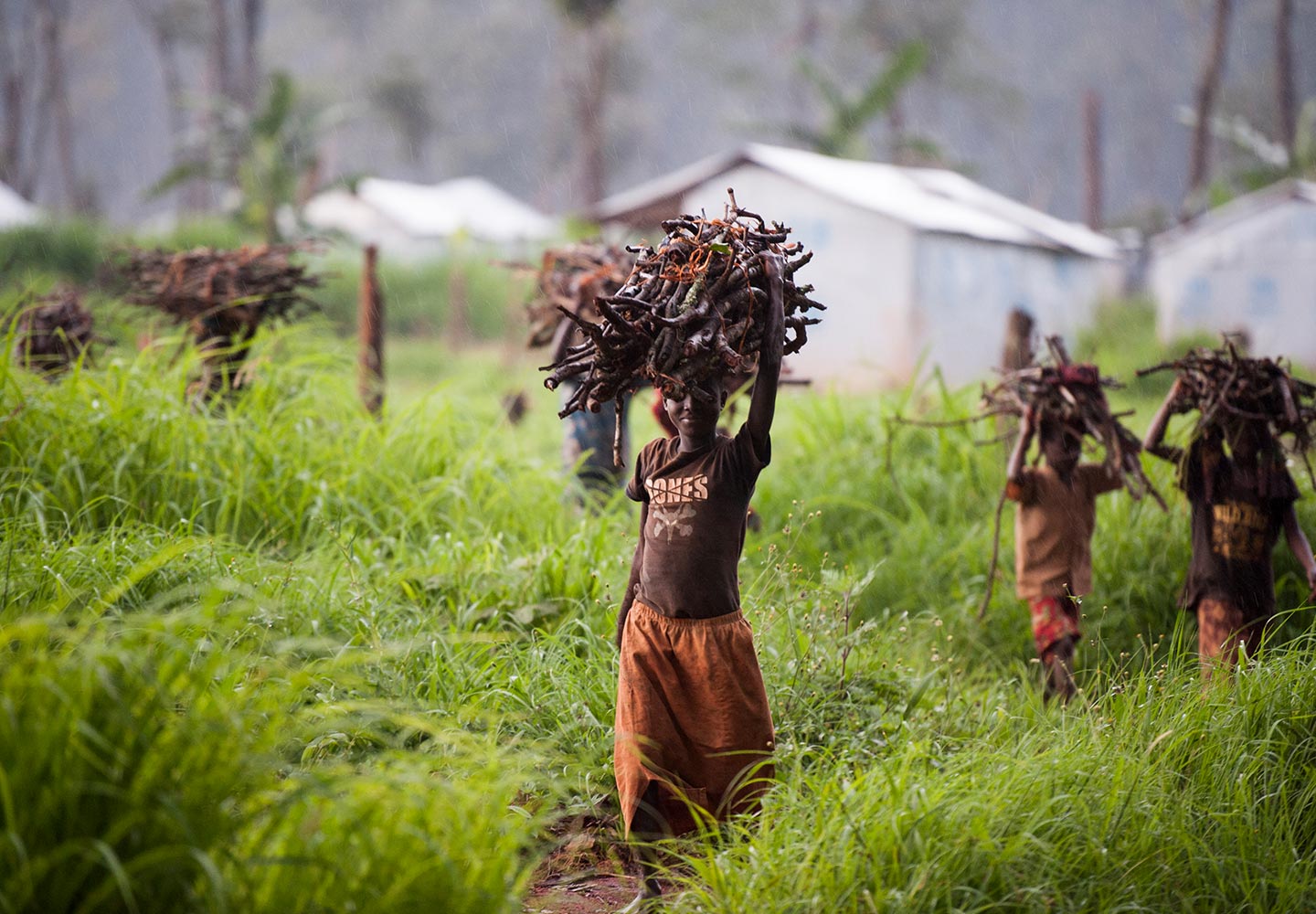
Refugee girls from Burundi collect firewood in the rain near Nduta refugee camp, Tanzania. © UNHCR/Sebastian Rich
These factors are amplified as girls get older – just as they should be preparing to transition to secondary school. If a refugee family has limited resources and must choose which siblings can continue with their education, UNHCR community-based protection staff have noted that boys are often prioritized because they are seen as having greater future earning potential. The situation is exacerbated because in many developing countries, the resources for secondary education are far less than for primary. Secondary education costs more – it requires more specialized equipment (laboratories for the sciences, for instance), more sophisticated learning materials and better qualified teachers.
School offers Syrian girls in Jordan the chance to flourish (Annie Sakkab, producer/camera/editor)
Girls may also have to battle social and cultural conventions and expectations. Some communities believe there is no need to educate girls, especially in places where child marriage and teenage pregnancy are the norm. Furthermore, if sexual and gender-based discrimination and violence is common in the communities that surround them, it is often found in school as well. Taken to extremes, religious hardliners have threatened and attacked girls, including refugees, who dared to defy them by attending school.
A school is made yet more unwelcoming if there is a lack of access to sanitation, clean water and private toilets. According to the World Bank, menstruation leads girls in sub-Saharan Africa to miss four days of school every four weeks, adding up to a loss of 10-20% of school time.[10] Without clean water and toilet facilities to wash clothes and uniforms, the provision of menstrual hygiene products, and sensitivity to the subject among both school staff and their classmates, it is easy to see why girls, both refugees and from the host community, would be forced to miss school.
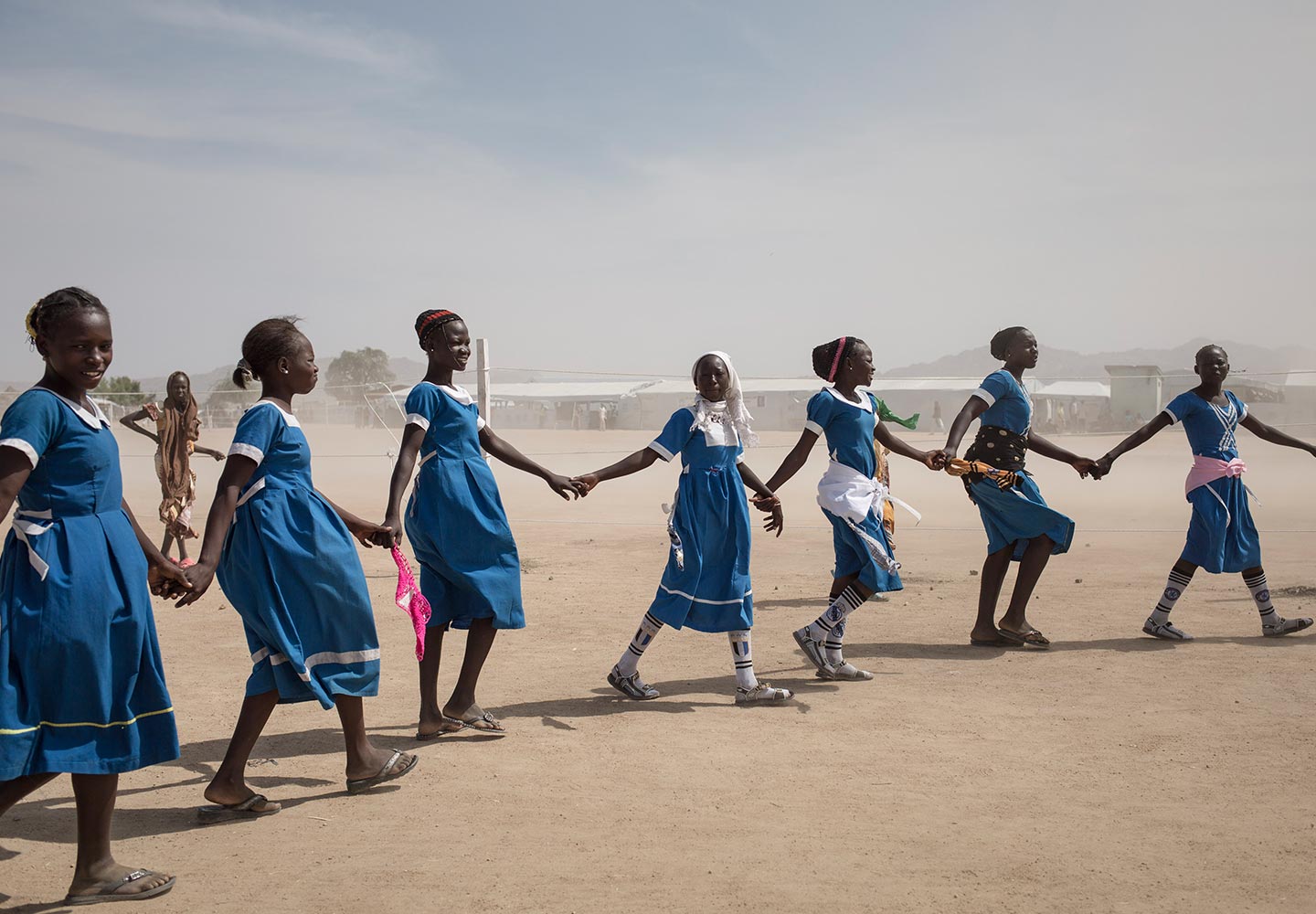
A group of Nigerian refugee schoolgirls at Minawao refugee camp in Cameroon. © UNHCR/Alexis Huguet
All this creates a self-perpetuating system that works against girls: the fewer girls who are educated, the fewer female teachers there will be who can buck these trends and act as role models. Conversely, dedicated and inspirational female teachers such as Afghan refugee, Aqeela Asifi, winner of the 2015 Nansen prize – an annual award for outstanding service to the cause of refugees – has transformed the lives of hundreds of Afghan refugee girls with her teaching. After years of dedication, she was recently able to expand her school in Kot Chandna, a remote village in Pakistan. “My students would always ask for the same thing – to be able to continue their education past the eighth grade,” she said. “Now we can make this dream a reality.”
7 ways to help refugee girls go to school
Esther Nyakong, 17, South Sudanese refugee rehearsing a dance at her school in Kakuma refugee camp, Kenya. © UNHCR/Benjamin Loyseau
1. Schools must make space for girls.
It is girls who most often lose out in the competition for a place in the classroom. More school places for refugee girls – and for their peers in the communities that host them – are desperately needed. Refugee children around the world are affected by a shortage of school places, particularly at secondary level, where the shortfall is acute.[11] Donors and agencies alike need to support policies that ensure inclusive and equitable access as the way to redress the balance. By boosting capacity, we will also benefit girls in host communities as well as refugees, bringing long-term advantages and improved resilience to successive generations in areas that need help the most.
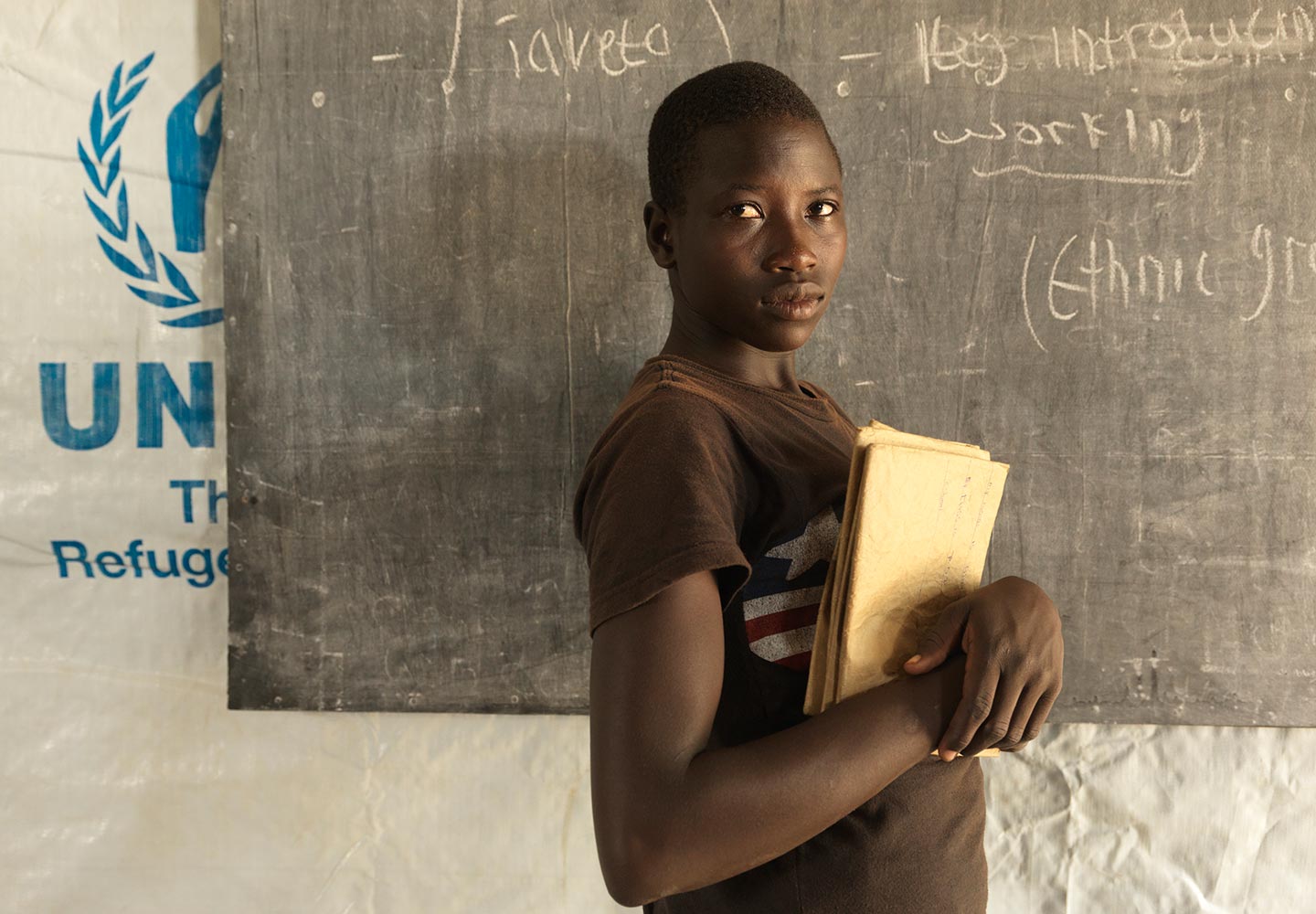
Tabu Sunday, 14, at school in Imvepi settlement, Uganda. She enjoys attending school despite overcrowded classrooms. © UNHCR/Peter Caton
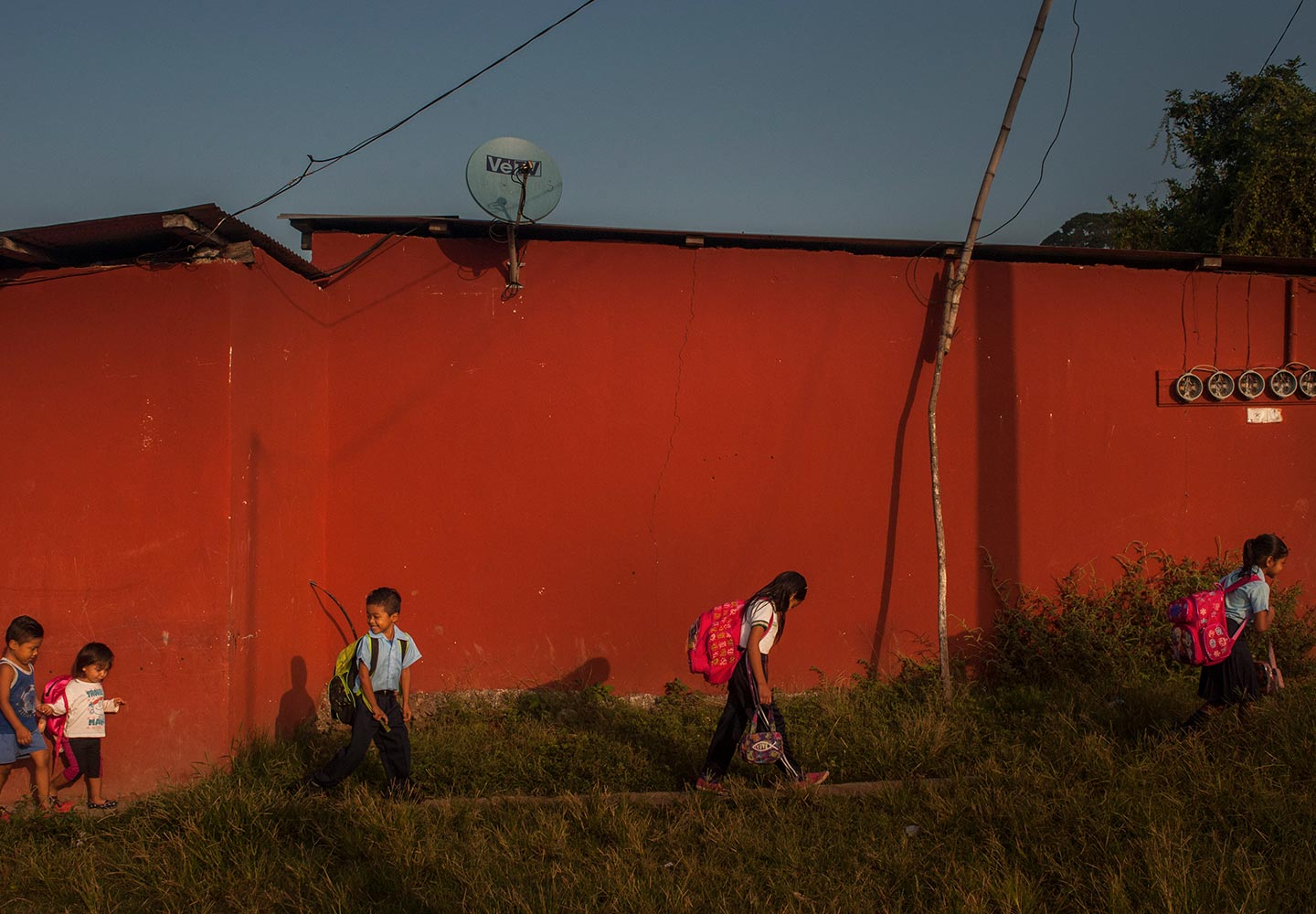
Refugee children from El Salvador walk to school in Chiapas, Mexico. A growing refugee crisis in Central America has seen hundreds of thousands escape gang violence in El Salvador, Honduras and Guatemala. © UNHCR/Daniele Volpe
2. No girl should miss school because the journey to school is too far or too dangerous.
Refugee girls need better protection from harassment, sexual assault and kidnap on the way to school. Community action to protect refugee children with support from local authorities should be a priority. “School trains,” when groups of pupils travel together with a regular adult escort, are a solution when the school is within walking distance. However, long journeys to secondary school are a deterrent for many children, particularly girls. Improved transport, such as the provision of all-girl buses, can determine whether refugee girls are allowed to go to school by their parents or not. Boarding schools for girls have proven successful in some settings, as well as hostels where girls can stay in safety during the school week or term.

Refugee children from El Salvador walk to school in Chiapas, Mexico. A growing refugee crisis in Central America has seen hundreds of thousands escape gang violence in El Salvador, Honduras and Guatemala. © UNHCR/Daniele Volpe
3. Schools must be adapted to girls’ needs.
No girl should have to miss school because they lack menstrual hygiene products, access to clean water or private and safe toilets. When separate toilet facilities are not provided for girls, they are less likely to go to school. Schools need support to provide these basic facilities and products.
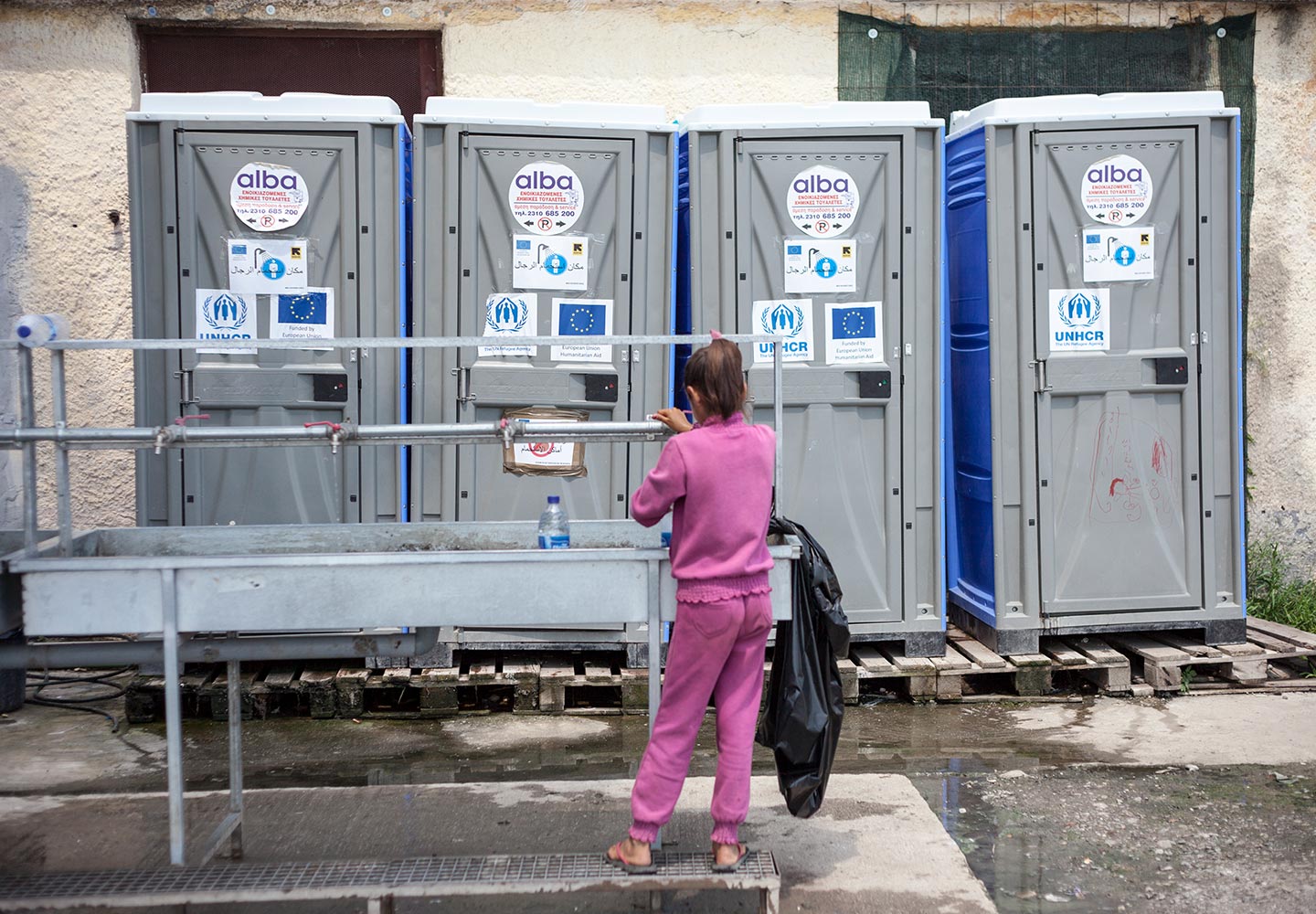
Toilets at an accommodation site for refugees in Alexandria, Greece. © UNHCR/Yorgos Kyvernitis
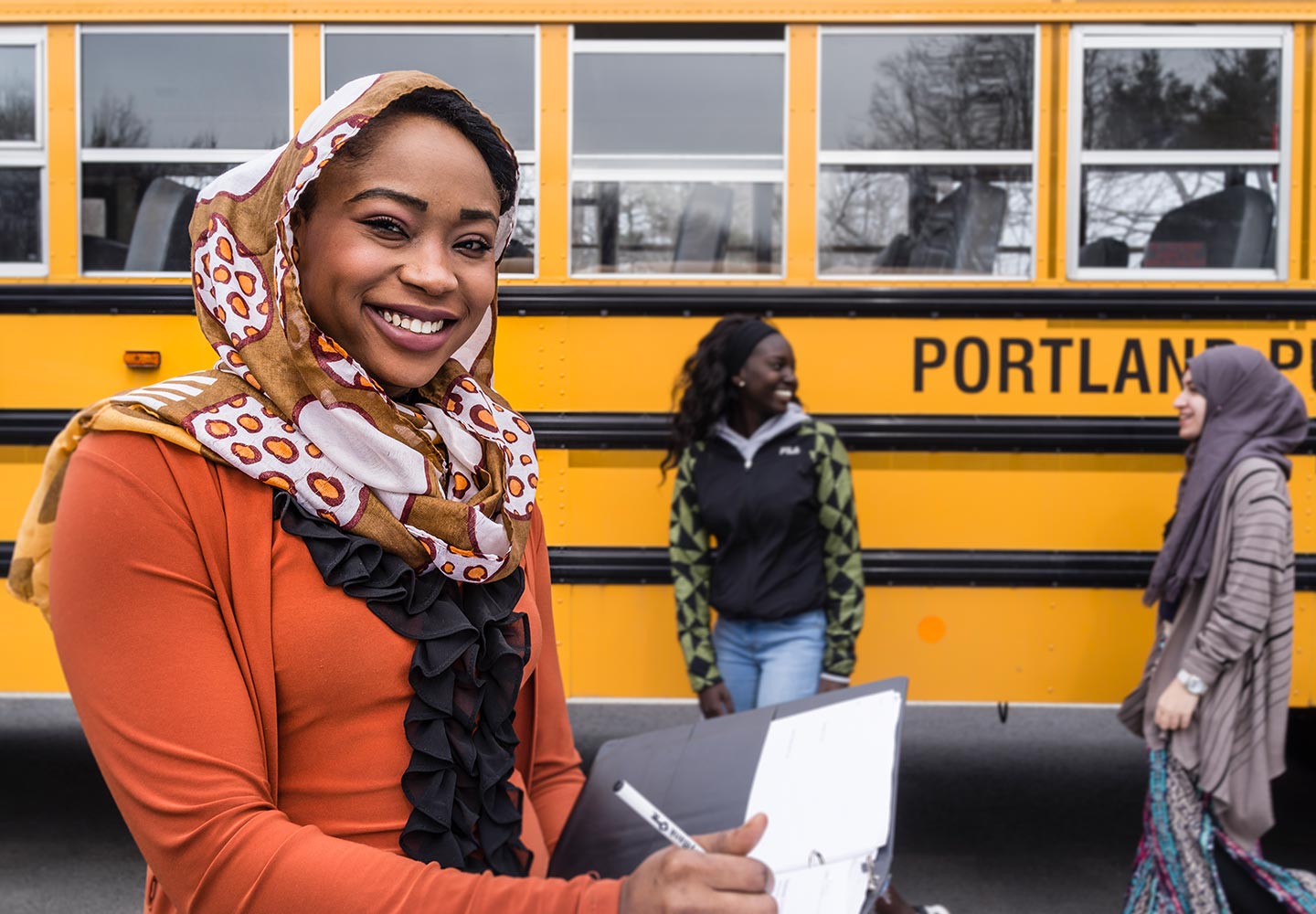
Ekhlas Ahmed accompanies her students on a field trip in Portland, Maine, United States. Ekhlas is a refugee from Sudan who was resettled to the USA as a child and is now a high school teacher. © UNHCR/Heather Perry
4. There can be no room for gender-based bullying, harassment and violence in schools.
Male and female teachers require ongoing training to ensure they promote best practice and guard against behaviour that will deter girls from setting foot in the classroom. Teachers are in the perfect position to promote and instil ideas of gender equality and mutual respect among girls and boys.

Ekhlas Ahmed accompanies her students on a field trip in Portland, Maine, United States. Ekhlas is a refugee from Sudan who was resettled to the USA as a child and is now a high school teacher. © UNHCR/Heather Perry
5. Refugee families need incentives and encouragement to keep girls in school.
If refugee adults are able to work and support their families, they are more likely to let their children stay in school. Frequent parent-teacher meetings can help parents understand their role in facilitating effective schooling. The provision of light and sustainable energy to refugee homes can also enable many girls to go to school because they don’t need to spend hours collecting firewood. It also means they can do their homework or catch up on their studies after nightfall.
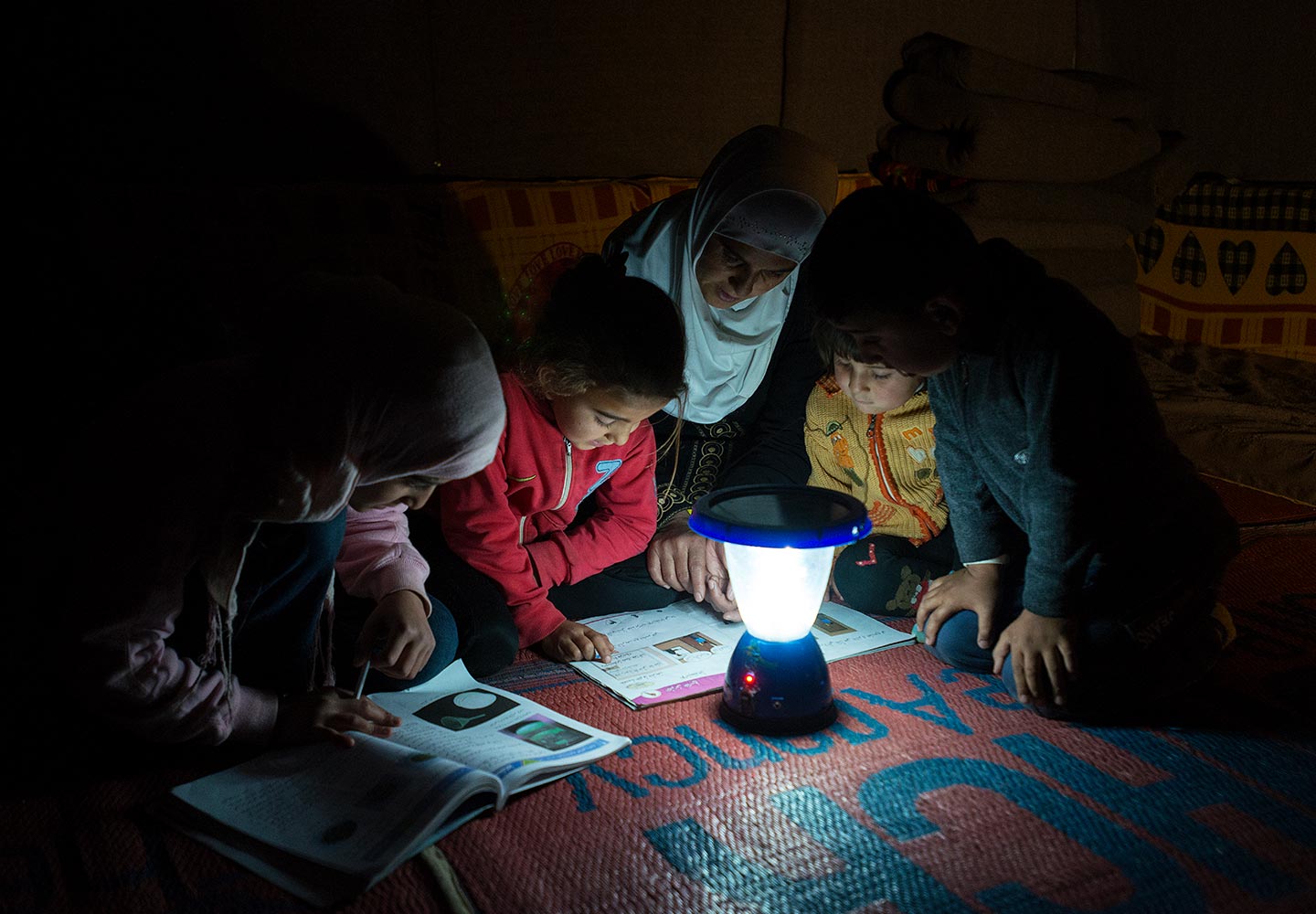
A Syrian refugee mother helps her children with their school work in Azraq refugee camp, Jordan, by the light of a solar powered lamp. © UNHCR/Sebastian Rich
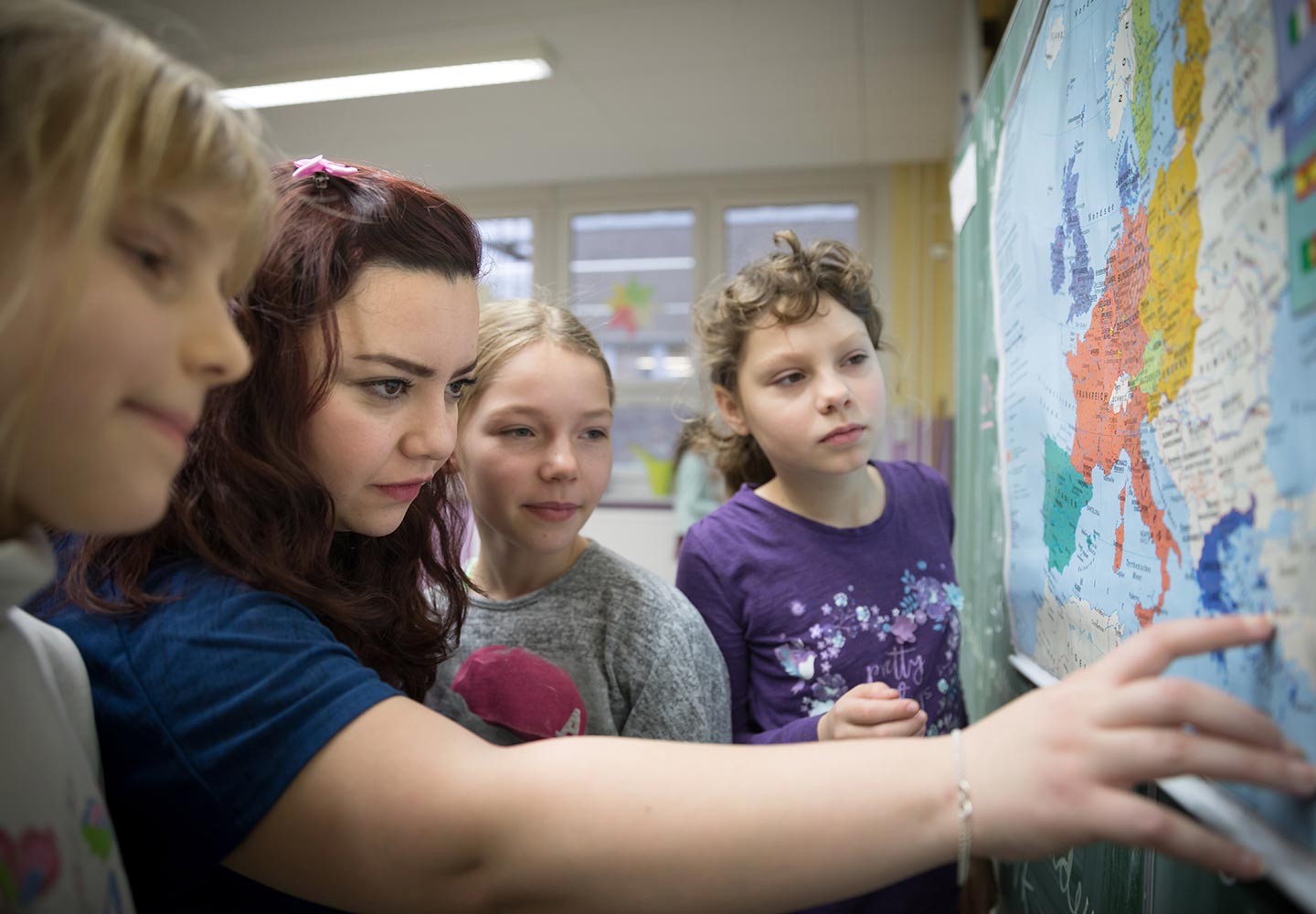
Alaa Kassab, 25, a refugee from Syria, is an assistant teacher at a primary school in Geltow, Germany. Before fleeing the war, she taught at a bilingual school in Aleppo. © UNHCR/Gordon Welters
6. Refugee pupils need more female teachers.
There is an urgent need to recruit and train more female teachers from within both host and refugee communities. Girls and boys need female role models, but girls in particular are likely to be encouraged and motivated by the presence of an educated woman in the classroom.

Alaa Kassab, 25, a refugee from Syria, is an assistant teacher at a primary school in Geltow, Germany. Before fleeing the war, she taught at a bilingual school in Aleppo. © UNHCR/Gordon Welters
7. With some extra help, girls can catch up and power on.
Extracurricular activities provide remedial, enrichment or mentoring services to enable girls to catch up (where necessary), boost their studies and thrive both academically and emotionally. While these should not be seen as an alternative to regular school, they can help to improve academic performance and, as a result, self-confidence.
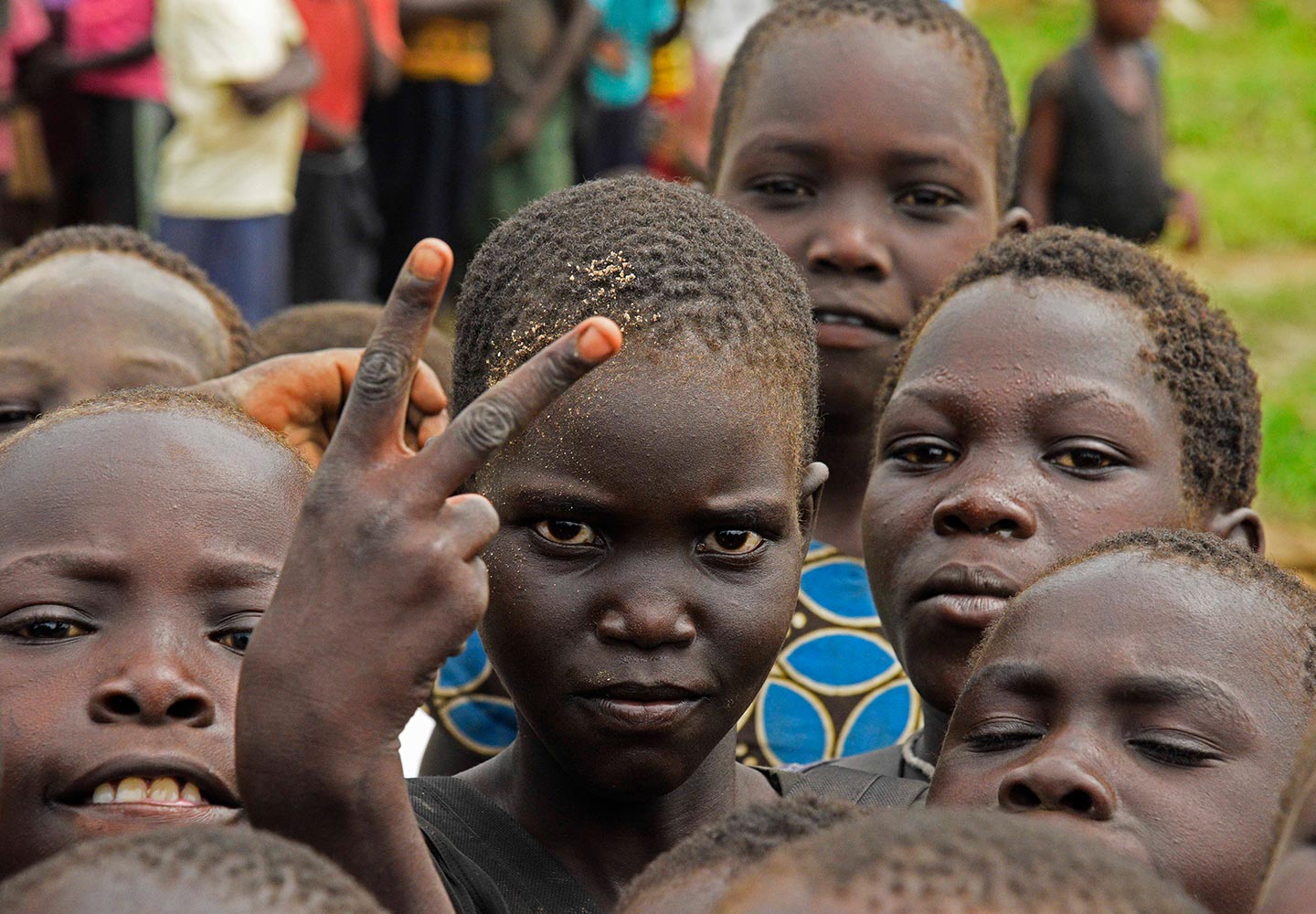
Refugee children from South Sudan attending primary school in Bidibidi refugee settlement in northern Uganda. © UNHCR/Isaac Kasamani
7 ways to help refugee girls go to school (Sylvie Francis, producer)
Final Word
By Emi Mahmoud, UNHCR High Profile SupporterEmi Mahmoud, UNHCR High Profile Supporter and poet, on a visit to Lesvos, Greece where she met with refugees. © UNHCR/Paul Wu
Refugees are constantly being told that they must remain silent. Yes, it is hard to be heard above the roar of warplanes or the thump of yet another explosion. But it’s also hard to be heard above the incessant refrain that refugees have a lesser right to exist – or none at all – and that refugee girls are worth less than anyone.
I have a voice. As a former refugee, a poet, a graduate of Yale University and now an advocate, I have been granted a platform to push back against the silence. Education changed my entire existence and so it is my duty to use my education to help others get to where I am today. Many people who have gone through what I have gone through, and worse, do not have this privilege.
When refugee girls are told they do not need or want an education, it is by people who do not want them to speak out, who do not want them to enrich their lives, to grow strong and prosper as human beings.
It is up to those of us who do have that voice to use it, as I will, and demand that all refugee girls, wherever they live, are admitted to the classroom and given a voice of their own. That is their right as human beings.
Call to Action
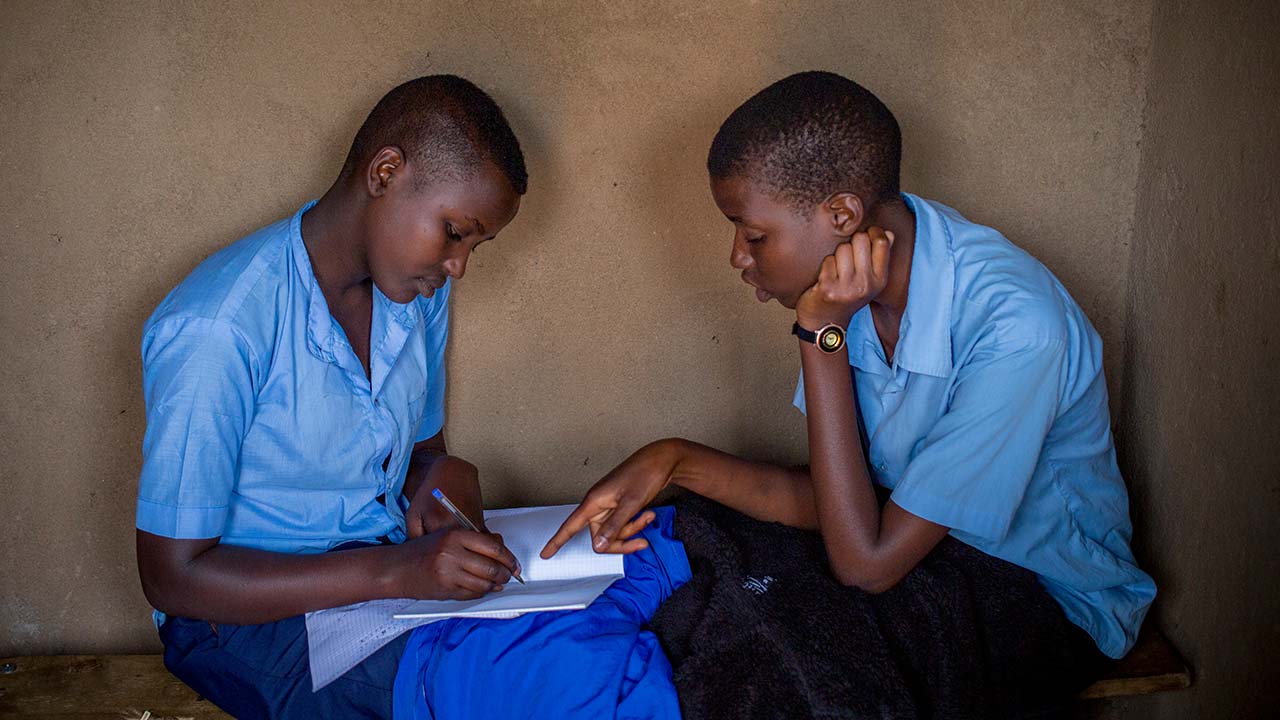
© UNHCR/Georgina Goodwin
Invest in refugee girls’ education:
Welcome refugees into your communities and offer to mentor refugee girls

© UNHCR/Scott Nelson
Stand #WithRefugees. Sign the petition asking decision makers to ensure every refugee child gets an education:
Sources
[1] World Bank: Returns to Investment in Education : A Global Update (1993)
[2] UNESCO: Global Education Monitoring Report (2014)
[3] UNESCO: Education Counts – Towards the Millennium Development Goals (2011)
[4] UNESCO: Education Transforms Lives (2013)
[5] Gakidou, Cowling, Lozano and Murray. (2010). Increased Educational Attainment and Its Effect on Child Mortality in 175 Countries between 1970 and 2009: A Systematic Analysis. The Lancet, Volume 376 (No. 9745), pp. 959-974
[6] UNESCO: Education Transforms Lives. Ibid.
[7] UNHCR: Global Trends Report (2016)
[9] Sperling and Winthrop. (2016). What Works in Girls’ Education. Brookings Institution Press.
[10] World Bank: Toolkit on Hygiene, Sanitation and Water in Schools (2005)
[11] UNHCR: Education Report – Left Behind: Refugee Education in Crisis (2017)

